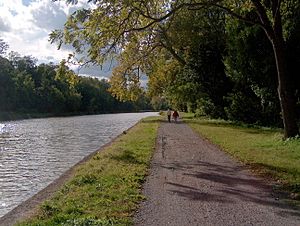New York State Canal System facts for kids
|
New York State Barge Canal
|
|

Lock 30 at Macedon, 2006
|
|
| Location | 17 counties in upstate New York |
|---|---|
| Area | 36.7 square miles (95 km2) |
| Built | 1905–63 |
| Architect | New York State Engineer's and Surveyor's Office: Edward Bond Austin, Frank Martin Williams, David Alexander Watt, A.A. Conger, William R. Davis |
| NRHP reference No. | 14000860 |
Quick facts for kids Significant dates |
|
| Added to NRHP | October 15, 2014 |
| Designated NHLD | December 23, 2016 |
The New York State Canal System is a network of waterways in New York. It took over from the famous Erie Canal and other older canals. This system is about 525 miles (845 km) long. It includes the Erie Canal, the Oswego Canal, the Cayuga–Seneca Canal, and the Champlain Canal.
In 2014, the entire canal system was recognized as a national historic district. This means it's an important place in history. In 2016, it was named a National Historic Landmark, showing its even greater historical value.
The Erie Canal connects the Hudson River to Lake Erie. The Cayuga–Seneca Canal links Seneca Lake and Cayuga Lake to the Erie Canal. The Oswego Canal connects the Erie Canal to Lake Ontario. Finally, the Champlain Canal joins the Hudson River to Lake Champlain.
Contents
Building the New York Canal System
In 1903, New York State leaders decided to build a new canal system. They called it the "New York State Barge Canal." This project was meant to improve the Erie, Oswego, Champlain, and Cayuga and Seneca Canals.
Construction of the Barge Canal started in 1905. It was a huge project that cost about $96.7 million. The canal system was finished in 1918. It officially opened for boats on May 15, 1918.
How the Canal Route Changed
The new Barge Canal used natural rivers that the original Erie Canal had avoided. These rivers included the Mohawk River, Oswego River, Seneca River, Genesee River, and Clyde River. Because of this, the canal no longer passed through some major cities like Syracuse and Rochester. However, in some parts of western New York, the new canal used the same path as the old Erie Canal, just made it wider.
In 1924, a special terminal was built in Brooklyn called the Gowanus Bay Terminal. This was made to help handle cargo coming from the canal.
The Canal Today
Since the 1970s, the state stopped making big updates to the canal system. This was because most goods started being moved by trucks instead of boats. Today, the canal is mainly kept for its history and for fun activities like boating. It also helps control floods.
Very few commercial boats use the canal now. Most of the boats you see are private pleasure boats. The last regular cargo ship, the Day Peckinpaugh, stopped running in 1994.
Since 1992, the name "Barge Canal" is no longer used. Each part of the system is now called by its original name. These are the Erie Canal, Oswego Canal, Cayuga–Seneca Canal, and Champlain Canal.
Canal Size and Operation
Today, the canals are about 12 feet (3.7 meters) deep and 120 feet (37 meters) wide. They have 57 locks that are run by electricity. These locks can handle boats as heavy as 2,000 tons (1,800 metric tons).

The canal system is usually open for boats from May 1 to November 15 each year. If you want to use a motorized boat, you need to pay a fee for a permit. This permit lets you go through the locks and under the lift bridges.
In 2004, over 122,000 recreational boats used the canal locks. Also, more than 8,500 tour boats and 7,300 rental boats used them. About 12,000 tons of cargo, worth $102 million, were shipped on the canal that year. By 2012, the amount of cargo shipped reached 42,000 tons. In 2017, over 200,000 tons of cargo were expected, which was the most since 1993.
Challenges and Flooding
In 2006, severe flooding in Upstate New York caused big problems for the canal. The damage was estimated to be at least $15 million.
In 2011, two big storms, Tropical Storm Irene and Tropical Storm Lee, caused more flooding. This led to almost the entire canal being closed. Some locks were so damaged that parts of the canal stayed closed for months. Luckily, the canal was fully open again for the 2012 boating season.
Managing the Canal System
The New York State Canal Corporation is in charge of the New York State Canal System. They oversee how it works, manage it, and keep it in good condition.
In 2012, the Canal Corporation had 529 employees. Most of these were full-time workers, and some were seasonal. Their spending was about 10% of the total budget for the New York State Thruway Authority, which they were part of at the time. Their operating budget was $55.7 million, and their capital budget was $51.4 million.
A report in 2012 said that the canal system was costing the Thruway Authority a lot of money. This was happening even though fewer boats were using the canal.
On January 1, 2017, the New York State Canal Corporation became part of the New York Power Authority. This change was approved in April 2016. The Canal Corporation's main office also moved to the Power Authority's regional offices in Albany.



